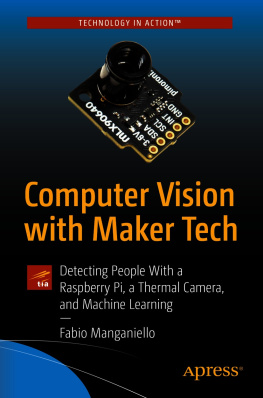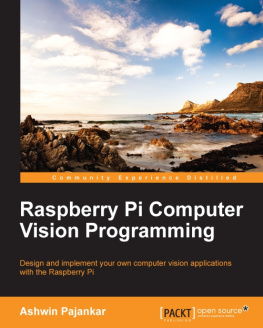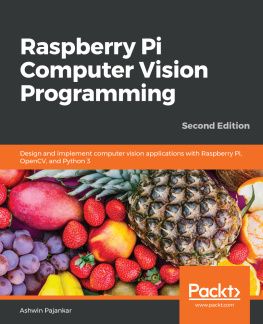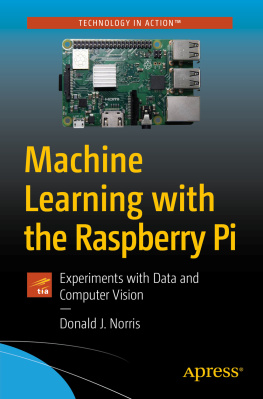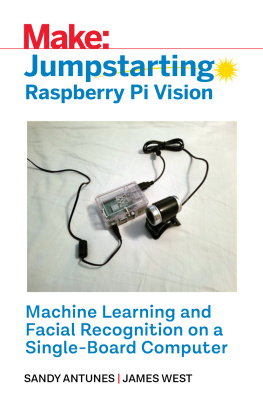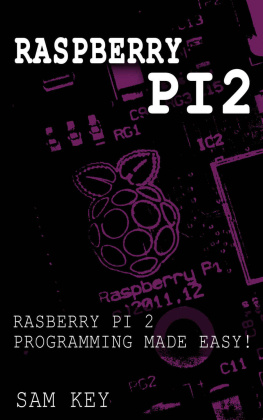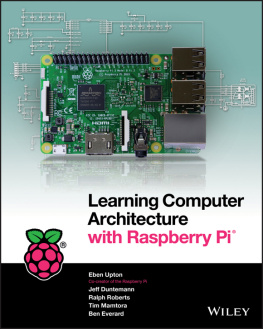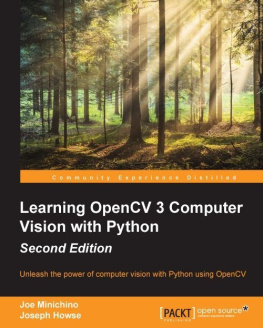Fabio Manganiello - Computer Vision with Master Tech: Detecting People With a Raspberry Pi, a Thermal Camera, and Machine Learning
Here you can read online Fabio Manganiello - Computer Vision with Master Tech: Detecting People With a Raspberry Pi, a Thermal Camera, and Machine Learning full text of the book (entire story) in english for free. Download pdf and epub, get meaning, cover and reviews about this ebook. publisher: Apress, genre: Home and family. Description of the work, (preface) as well as reviews are available. Best literature library LitArk.com created for fans of good reading and offers a wide selection of genres:
Romance novel
Science fiction
Adventure
Detective
Science
History
Home and family
Prose
Art
Politics
Computer
Non-fiction
Religion
Business
Children
Humor
Choose a favorite category and find really read worthwhile books. Enjoy immersion in the world of imagination, feel the emotions of the characters or learn something new for yourself, make an fascinating discovery.
- Book:Computer Vision with Master Tech: Detecting People With a Raspberry Pi, a Thermal Camera, and Machine Learning
- Author:
- Publisher:Apress
- Genre:
- Rating:4 / 5
- Favourites:Add to favourites
- Your mark:
- 80
- 1
- 2
- 3
- 4
- 5
Computer Vision with Master Tech: Detecting People With a Raspberry Pi, a Thermal Camera, and Machine Learning: summary, description and annotation
We offer to read an annotation, description, summary or preface (depends on what the author of the book "Computer Vision with Master Tech: Detecting People With a Raspberry Pi, a Thermal Camera, and Machine Learning" wrote himself). If you haven't found the necessary information about the book — write in the comments, we will try to find it.
Fabio Manganiello: author's other books
Who wrote Computer Vision with Master Tech: Detecting People With a Raspberry Pi, a Thermal Camera, and Machine Learning? Find out the surname, the name of the author of the book and a list of all author's works by series.
Computer Vision with Master Tech: Detecting People With a Raspberry Pi, a Thermal Camera, and Machine Learning — read online for free the complete book (whole text) full work
Below is the text of the book, divided by pages. System saving the place of the last page read, allows you to conveniently read the book "Computer Vision with Master Tech: Detecting People With a Raspberry Pi, a Thermal Camera, and Machine Learning" online for free, without having to search again every time where you left off. Put a bookmark, and you can go to the page where you finished reading at any time.
Font size:
Interval:
Bookmark:


Any source code or other supplementary material referenced by the author in this book is available to readers on GitHub via the books product page, located at www.apress.com/978-1-4842-6820-9 . For more detailed information, please visit http://www.apress.com/source-code .
The field of machine learning has gone through a massive growth in the last few years, thanks to increased computing power, increased funding, and better frameworks that make it easier to build and train classifiers. Machine learning, however, is still considered as a tool for IT giants with plenty of resources, data, and computing power. While it is true that models get better when they can be trained with more data points, and computing power surely plays a role in the ability to train complex models, in this book we'll see that it's already possible to build models trained on data points gathered from a smart home environment (like temperature, humidity, presence, or camera images), and you can already use those models to make your home smarter. Such models can be used for predictions even on a Raspberry Pi or similar hardware.
Know the formal foundations of the main machine learning techniques
Know how to estimate how accurate a classifier is in making predictions and what to tweak in order to improve its performance
Know how to cleanse and preprocess your data points to maximize the performance of your models
Be able to build machine learning models using TensorFlow and the standard Python stack for data analysis (numpy, matplotlib, pandas)
Be able to set up a Raspberry Pi with a simple network of sensors, cameras, or other data sources that can be used to generate data points fed to simple machine learning models, make predictions on those data points, and easily create, train, and deploy models through web services
Chapter will go through the theoretical foundations of machine learning. It will cover the most popular approaches to machine learning, the difference between supervised and unsupervised learning, and take a deep dive into regression algorithms (the foundation block for most of today's supervised learning). It will also cover the most popular strategies to visualize, evaluate, and tweak the performance of a model.
Chapter will take a deep dive into neural networks, how they operate and learn, and how they use computer vision. It will also cover convolutional neural networks (CNNs), a popular architecture used in most of today's computer vision classification models.
Chapter will provide an overview of the most common tools used by makers in IoT today with a particular focus on the Raspberry Pi. We'll see how to use one of these devices to collect, send, and store data points that can be used to train machine learning models, and to train a simple model to detect the presence of people in a room using a cheap camera, and how to use it to make predictions within a home automation flowfor example, turn the lights on/off when presence is detected or send a notification when presence is detected but we are not home. The chapter will also provide an introduction to some strategies for semi-supervised learning and show how to wrap a web service around TensorFlow to programmatically create, train, and manage models.

has more than 15 years of experience in software engineering, many of these spent working on machine learning and distributed systems. In his career he has worked, among others, on natural language processing, an early voice assistant (Voxifera) developed back in 2008, and machine learning applied to intrusion detection systems, using both supervised and unsupervised learning; and he has developed and released several libraries to make models design and training easier, from back-propagation neural networks (Neuralpp) to self-organizing maps (fsom), to dataset clustering. He has contributed to the design of machine learning models for anomaly detection and image similarity in his career as a tech lead in Booking.com. In the recent years, he has combined his passion for machine learning with IoT and distributed systems. From self-driving robots to people detection, to anomaly detection, to weather forecasting, he likes to combine the flexibility and affordability of tools such as Raspberry Pi, Arduino, ESP8266, and cheap sensors with the power of machine learning models. He's an active IEEE member and open source enthusiast and has contributed to around 100 open source projects over the years. He is the creator and main contributor of Platypush, an all-purpose platform for automation that aims to connect any device to any service, and also provides TensorFlow and OpenCV integrations for machine learning.
graduated from BITS Pilani, where he studied mechanical engineering, in 2018. Since then, he has worked with Big Vision LLC on deep learning and computer vision and was involved in creating official OpenCV AI courses. Currently, he is working at Mercedes-Benz Research and Development India Pvt. Ltd. He has a keen interest in programming and AI and has applied that interest in mechanical engineering projects. He has also written multiple blogs on OpenCV and deep learning on Learn OpenCV, a leading blog on computer vision. He has also coauthored
Font size:
Interval:
Bookmark:
Similar books «Computer Vision with Master Tech: Detecting People With a Raspberry Pi, a Thermal Camera, and Machine Learning»
Look at similar books to Computer Vision with Master Tech: Detecting People With a Raspberry Pi, a Thermal Camera, and Machine Learning. We have selected literature similar in name and meaning in the hope of providing readers with more options to find new, interesting, not yet read works.
Discussion, reviews of the book Computer Vision with Master Tech: Detecting People With a Raspberry Pi, a Thermal Camera, and Machine Learning and just readers' own opinions. Leave your comments, write what you think about the work, its meaning or the main characters. Specify what exactly you liked and what you didn't like, and why you think so.

